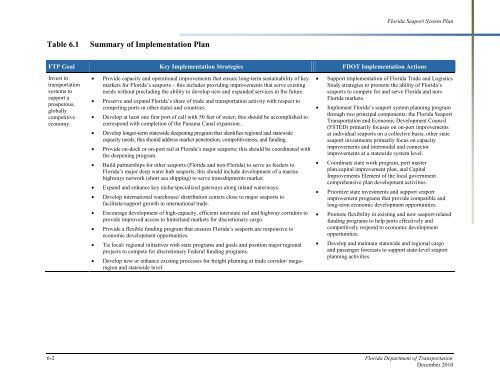Florida Seaport System Plan - SeaCIP
Florida Seaport System Plan - SeaCIP
Florida Seaport System Plan - SeaCIP
Create successful ePaper yourself
Turn your PDF publications into a flip-book with our unique Google optimized e-Paper software.
<strong>Florida</strong> <strong>Seaport</strong> <strong>System</strong> <strong>Plan</strong><br />
Table 6.1<br />
Summary of Implementation <strong>Plan</strong><br />
FTP Goal Key Implementation Strategies FDOT Implementation Actions<br />
Invest in<br />
transportation<br />
systems to<br />
support a<br />
prosperous,<br />
globally<br />
competitive<br />
economy.<br />
• Provide capacity and operational improvements that ensure long-term sustainability of key<br />
markets for <strong>Florida</strong>’s seaports – this includes providing improvements that serve existing<br />
needs without precluding the ability to develop new and expanded services in the future.<br />
• Preserve and expand <strong>Florida</strong>’s share of trade and transportation activity with respect to<br />
competing ports in other states and countries.<br />
• Develop at least one first port of call with 50 feet of water; this should be accomplished to<br />
correspond with completion of the Panama Canal expansion.<br />
• Develop longer-term statewide deepening program that identifies regional and statewide<br />
capacity needs; this should address market penetration, competitiveness, and funding.<br />
• Provide on-dock or on-port rail at <strong>Florida</strong>’s major seaports; this should be coordinated with<br />
the deepening program.<br />
• Build partnerships for other seaports (<strong>Florida</strong> and non-<strong>Florida</strong>) to serve as feeders to<br />
<strong>Florida</strong>’s major deep water hub seaports; this should include development of a marine<br />
highways network (short sea shipping) to serve transshipments market.<br />
• Expand and enhance key niche/specialized gateways along inland waterways.<br />
• Develop international warehouse/ distribution centers close to major seaports to<br />
facilitate/support growth in international trade.<br />
• Encourage development of high-capacity, efficient interstate rail and highway corridors to<br />
provide improved access to hinterland markets for discretionary cargo.<br />
• Provide a flexible funding program that ensures <strong>Florida</strong>’s seaports are responsive to<br />
economic development opportunities.<br />
• Tie local/ regional initiatives with state programs and goals and position major regional<br />
projects to compete for discretionary Federal funding programs.<br />
• Develop new or enhance existing processes for freight planning at trade corridor/ megaregion<br />
and statewide level.<br />
• Support implementation of <strong>Florida</strong> Trade and Logistics<br />
Study strategies to promote the ability of <strong>Florida</strong>’s<br />
seaports to compete for and serve <strong>Florida</strong> and non-<br />
<strong>Florida</strong> markets.<br />
• Implement <strong>Florida</strong>’s seaport system planning program<br />
through two principal components; the <strong>Florida</strong> <strong>Seaport</strong><br />
Transportation and Economic Development Council<br />
(FSTED) primarily focuses on on-port improvements<br />
at individual seaports on a collective basis; other state<br />
seaport investments primarily focus on capacity<br />
improvements and intermodal and connector<br />
improvements at a statewide system level.<br />
• Coordinate state work program, port master<br />
plan/capital improvement plan, and Capital<br />
Improvements Element of the local government<br />
comprehensive plan development activities.<br />
• Prioritize state investments and support seaport<br />
improvement programs that provide compatible and<br />
long-term economic development opportunities.<br />
• Promote flexibility in existing and new seaport-related<br />
funding programs to help ports effectively and<br />
competitively respond to economic development<br />
opportunities.<br />
• Develop and maintain statewide and regional cargo<br />
and passenger forecasts to support state-level seaport<br />
planning activities.<br />
6-2 <strong>Florida</strong> Department of Transportation<br />
December 2010
















